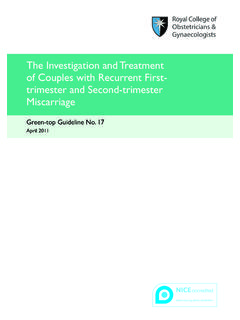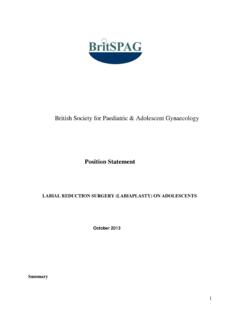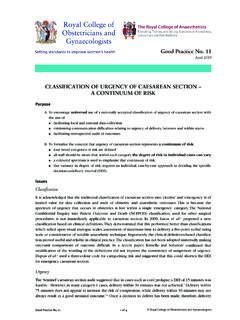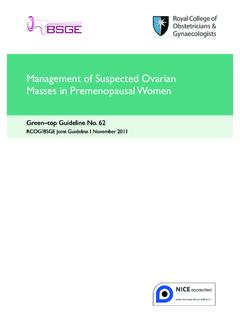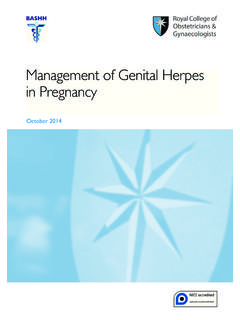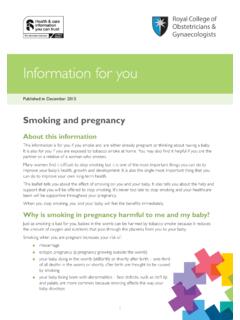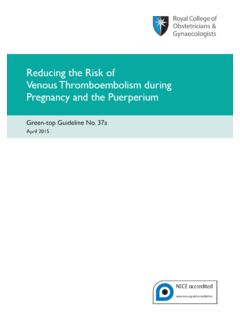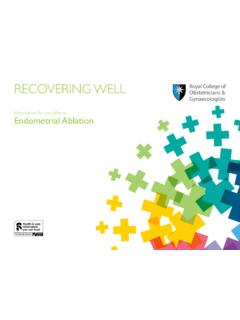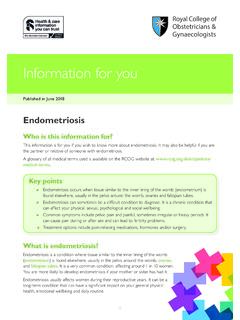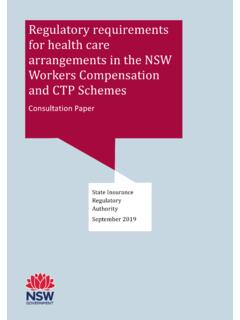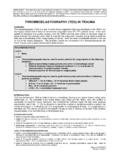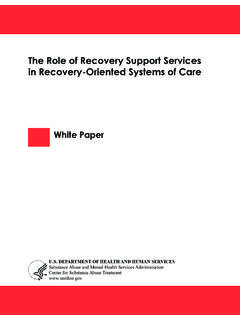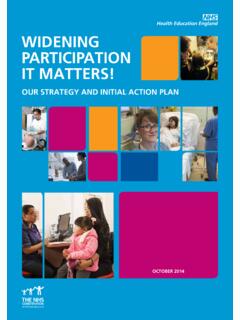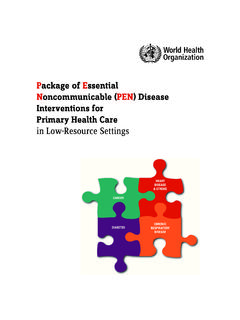Transcription of PROVIDING QUALITY PROVIDING QUALITY CARE PATIENT …
1 PROVIDING QUALITY . PROVIDING QUALITY care . FOR WOMEN. PATIENT care . A. A FRAMEWORK. MATERNITY FOR. STANDARDS. FRAMEWORK FOR. MATERNITY. MATERNITY SERVICE. SERVICESTANDARDS. STANDARDS. PROVIDING QUALITY . PROVIDING QUALITY care . FOR WOMEN. PATIENT care . A. A FRAMEWORK. MATERNITY FOR. STANDARDS. FRAMEWORK FOR. MATERNITY. MATERNITY SERVICE. SERVICESTANDARDS. STANDARDS. 2016 The Royal College of Obstetricians and Gynaecologists All rights reserved. No part of this publication may be reproduced, stored or transmitted in any form or by any means, without the prior written permission of the publisher or, in the case of reprographic reproduction, in accordance with the terms of licences issued by the Copyright Licensing Agency in the UK [ ]. Enquiries concerning reproduction outside the terms stated here should be sent to the publisher at the UK address printed on this page.
2 Published by the Royal College of Obstetricians and Gynaecologists 27 Sussex Place Regent's Park London NW1 4RG. Registered Charity No. 213280. Edited by: Suzie Boyd Design and typesetting: James Pembroke Publishing Cover design: Cavendish Design & Advertising Ltd Endorsed by: PROVIDING QUALITY . Contents PATIENT care . MATERNITY STANDARDS. Introduction 4. 1 Overarching standards 6. 2 Pre-pregnancy services 13. 3 Antenatal care 15. 4 Vulnerable women 18. 5 Medical complexity 30. 6 Inpatient care 34. 7 Elective birth 37. 8 Intrapartum care 43. 9 Postnatal care 53. 10 Fetal medicine 61. 11 Perinatal loss 64. Appendix 1 68. Acknowledgements Appendix 2 69. Glossary References 70. 3. A framework for maternity service standards Introduction SERVICE SPECIFICATIONS needs to be safe, effective, timely, efficient, A ND STA NDA R DS FOR equitable, and people-centred.'1 3.
3 THE PROVISION OF We envisage that multi-disciplinary teams will M ATER NIT Y CA R E use the framework and standards to ensure their contributions meet the needs of women, their IN 2015, the RCOG established the Safer babies and their families, whether or not they Women's Health care working party to have medical or obstetric complications. The identify the workforce and service standards framework and standards should also support needed to deliver safe, high- QUALITY maternity maternity staff to work in well-structured and gynaecological care . This report is the teams, with supportive line management and output of the multi-disciplinary maternity infrastructure to deliver safe, personal, kind, standards work stream. It sets out a professional and high- QUALITY maternity care . framework for commissioners and service The framework is a progression of the providers of high-level maternity service national standards for maternity care standards that aim to improve outcomes and developed by an inter-disciplinary expert reduce variation in maternity care .
4 There working party and published by the RCOG in is also an accompanying framework for 2008. 5 The 2008 document covers a mixture gynaecology services. of clinical and organisational standards and The maternity service standards framework continues to be a highly relevant reference is based on the principle that QUALITY resource for service providers, commissioners, improvement demands continuous effort. healthcare professionals and for women, and The standards define QUALITY of care within for QUALITY improvement in UK maternity care . maternity, building on the WHO vision which This new framework for maternity service defines QUALITY of care as the extent to which standards builds on this to offer providers and health care services provided to individuals commissioners a contemporary structure for and PATIENT populations improve desired health the delivery of QUALITY improvement and safe outcomes.
5 In order to achieve this, health care maternity care . This report sets out a framework for commissioners and service providers of high-level maternity service standards that aim to improve outcomes and reduce variation in maternity care 4. Introduction FOR M AT A ND CONTENT The standards have been developed recognising that: OF THIS R EPORT. High QUALITY The first section of the report presents High QUALITY maternity care is provided maternity care overarching service standards which cover through services that nurture and develop elements of QUALITY such as communication, service trusting and responsive relationships with is provided governance, staffing, education, accountability, the women and their families they serve. through services family centred care , and the care and birth environment. Delivering such QUALITY means that the that nurture and Subsequent sections present key service service providers work in collaboration with all key stakeholders and engage develop trusting standards along the maternity pathway from preconception through pregnancy, labour and proactively with service users, ensuring and responsive birth, and the postnatal period.
6 That their views are sought when any Each section has at least one key statement significant changes to systems are relationships about care and then lists associated standards; proposed. with women and measurement criteria are given that could be used to show compliance. The criteria are examples and Service providers respond to feedback in their families are not all-inclusive. a timely manner and foster a culture of References are listed at the end of the report learning and supportive work practices which provide contextual evidence and information which is open and transparent in the and were used to develop the standards. Where response to and investigation of any critical there was limited evidence-based guidance, the incidents. standard has been developed through consensus and is referenced as group consensus.' These standards are most effectively delivered The statements and standards were developed within an interconnected system of service by a review of available evidence, discussion providers, working, for example within amongst work stream group members and through collaborative supra-local network structures which pragmatic informal discussion with colleagues and provide strategic and/or operational all relevant stake holders including service users.
7 Such networks are essential to ensure that women have timely access when they need it to a multi- professional team that works in partnership with local and regional specialists and agencies which ensures seamless links between primary, secondary, specialist and community services. Effective networks should also ensure that no woman is exposed to unnecessary intervention or remains at an inappropriately escalated level of , 3. 5. A framework for maternity service standards 1 O. verarching standards for services throughout the maternity pathway care must be accessible, responsive and provided in partnership with women and their families, respecting their diverse health and wellbeing needs, preferences and choices;. and in collaboration with other organisations whose services impact on family wellbeing. STATEMENTS & STANDARDS MEASUREMENT CRITERIA REFERENCE. Commissioners and providers of maternity Network policy and audit Previous RCOG.
8 Healthcare should ensure that there are a variety of Maternity Standards5. routes and mechanisms for women to access care in a timely manner whether during pregnancy, birth or the NHS London6. postnatal period. 2 Systems should be in place to ensure there Network policy and audit HSCIC7. is outreach to frequently excluded groups, encouraging them to engage with services. 3 Services should be planned on the basis of Local joint assessment National Maternity high QUALITY information about local population needs. and planning Review8. Network policy There should be effective partnership Local policy and audit National Maternity working across communities, including local authorities Review8. and the voluntary sector, PROVIDING pathways of care with access to social care agencies. 5 There should be a structure that addresses Local policy and audit RCPCH9. the requirements of the relevant Children and Young People's legislation which includes safeguarding policies and collaboration with the relevant local networks.
9 6. 1 Overarching standards STATEMENTS & STANDARDS MEASUREMENT CRITERIA REFERENCE. There should be evidence that the local Local policy and audit Public Health Maternity Services Liaison Committee (MSLC) or England10. other such structures embed user involvement to develop and improve services. Feedback from women and their families' Local policy and audit National Maternity experiences must be used to drive continuous Review8. improvement of care . The service provider should ensure that Local policy and audit The King's Fund12. generic pre-pregnancy advice should be included in all consultations, medical and surgical, with women of RCM standards for reproductive age, regardless of indication, in primary mental health13. and secondary care , including lifestyle and healthy eating, weight optimisation, smoking reduction/. cessation, appropriate dietary supplementation, review of medication, and social support.
10 1 . 1 . 9 The provider should ensure that there Network policy and audit The King's Fund12. must be appropriate provision for investigation and optimisation of physical and mental health prior to Network wide level RCM standards for pregnancy as well as a full range of support services agreement mental health13. to provide antenatal, intrapartum and postnatal care for that woman once she conceives. Maternity services must demonstrate Local policy RCM14. encouragement and support for a woman's partner to be involved during maternity care to prepare Department of Health15. for parenthood. Staff must have the ability to communicate effectively with all members of the maternity team, other professionals, women receiving care and their family members. They should ensure that all information relevant to the care pathway is accessible, aids decision making and assists communication so that women are actively encouraged to express their preferences, listened to and supported to make personal choices, share decisions and take responsibility for their own health care .
